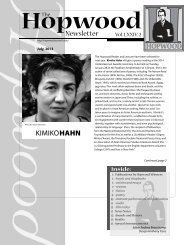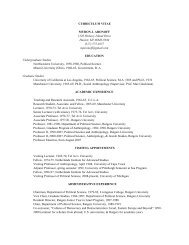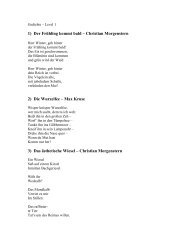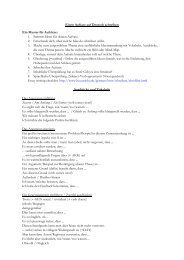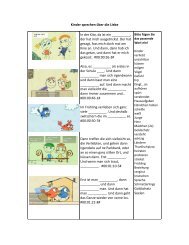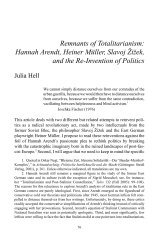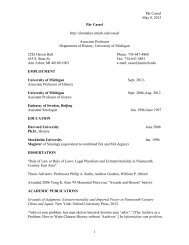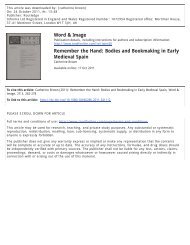Interview with Alumna Christine Orme (Ph.D. '95)
Interview with Alumna Christine Orme (Ph.D. '95)
Interview with Alumna Christine Orme (Ph.D. '95)
You also want an ePaper? Increase the reach of your titles
YUMPU automatically turns print PDFs into web optimized ePapers that Google loves.
<strong>Interview</strong> <strong>with</strong> <strong>Alumna</strong> <strong>Christine</strong> <strong>Orme</strong><br />
(<strong>Ph</strong>.D. ‘95)<br />
The Department Editor recently interviewed Michigan <strong>Ph</strong>ysics alumna <strong>Christine</strong> <strong>Orme</strong><br />
(<strong>Ph</strong>.D. ‘95) currently the Group Leader, Biophysical and Interfacial Science Group and<br />
the Acting Director, <strong>Ph</strong>ysical Biosciences Institute at the LLNL. She recently won the<br />
prestigious Presidential Early Career Award for Science and Engineering while working at<br />
LLNL, “for her work on understanding the physical mechanisms of biomineralization and<br />
the development of force microscopy-based methods of investigating mineralization at<br />
the nanoscale.” Due to space constraints in the newsletter, ony portions of the interview<br />
were published. You may find the entire interview below.<br />
How did you decide to become an undergraduate physics major?<br />
When I started college, my dad’s advice was to go to all the departmental colloquia<br />
and to figure out which served the best food and wine. Unfortunately, wine was<br />
being phased out as a normal colloquium experience so I could not really act on<br />
this sound advice. But, I took courses in biology, physiology, botany, chemistry, and<br />
finally physics. From my point of view, physics was the only one that relied on logic<br />
rather than memorization. Of course, I am now trying [to] integrate the other disciplines into my research and I regret<br />
not having learned a bit more biology and chemistry.<br />
What factors lead you to become a graduate student in physics? How did you decide to complete<br />
your graduate work at Michigan?<br />
The choice to go to graduate school wasn’t a big (meaning conflicted) decision for me. If you want to do research in<br />
physics you need a <strong>Ph</strong>.D. But, I did not know what area of physics I wanted to go in to when I applied for graduate<br />
schools so I chose a large school. I had also spent my entire life in California so I thought I should go elsewhere for a<br />
bit. When I entered graduate school, Michigan was in the midst of building up the [<strong>Ph</strong>ysics] Department again and was<br />
doing a lot of hiring – it was growing and their was a certain excitement due to the revitalization.<br />
Was your advisor Brad Orr? What type of physics did you study <strong>with</strong> him?<br />
Yes, <strong>with</strong> Professor Brad Orr, I studied how surface morphologies evolve as materials are being grown. In my case the<br />
surfaces were GaAs films grown using molecular beam epitaxy. But, in many ways, it did not matter what the material<br />
was. Brad’s group, along <strong>with</strong> Professor Len Sander’s group as well, was interested in knowing what would happen<br />
if you rained down atoms on a surface and then gave the atoms different rules for moving around. Could you create<br />
different patterns by changing the rules and could these patterns then explain the types of surface morphologies that<br />
we found in thin films grown in the lab?<br />
Do you have any interesting stories you can relate about your time at Michigan <strong>Ph</strong>ysics?<br />
At some point, several of us women in the Department decided that we needed our own gripe session to bemoan our<br />
progress so we would meet for dinner once or twice a month. One of the stranger findings was that each of us had<br />
developed some sort of stress-related tick. Several of us were having mandible joint problems from grinding teeth. For<br />
most of us, this meant that we had sore jaws or that we annoyed our partners but some had to wear retainers while<br />
they slept. Probably the most interesting example was a woman <strong>with</strong> very long, dark hair that had one section <strong>with</strong><br />
intermittent grey streaks that could be read off like a timeline – here are my oral exams, here is the DOE review…
Probably the most fortunate event was that I met my partner Jeff Witt in the <strong>Ph</strong>ysics Department. He was helping<br />
me leak test a vacuum chamber. To do this, we were flowing helium gas through a small hypodermic needle.<br />
Unfortunately, I turned the helium up a little too high and the hypodermic went flying across the room into Jeff’s arm.<br />
I suppose cupid needs to be a bit more creative in a physics lab.<br />
Tell me about your work career after you graduated?<br />
I went straight from Michigan to Lawrence Livermore National Lab (LLNL) where I worked <strong>with</strong> Professor Jim De Yoreo<br />
as a postdoctoral associate. I think that if I were to do this again, I would take a vacation in between. I got this job<br />
because Jim had asked Brad to give a talk at LLNL but Brad was about to leave for sabbatical so he sent me instead – I<br />
gave a talk which turned into an interview.<br />
Your work is quite interdisciplinary. How did your physics background prepare you to succeed in<br />
such multi-faceted research?<br />
I think the aesthetic in physics values [is] distilling your thoughts to the simplest and most logical form. This can really<br />
aid in communicating between disciplines by getting rid of extraneous details that make it harder to see connections.<br />
Of course, this can also lead to unphysical simplification, which is why it is crucial to work <strong>with</strong> people who challenge<br />
your choices.<br />
Can you tell me about the research which led you to win the Presidential Award?<br />
In many ways the biomineralization research was a direct outgrowth of my work as a graduate student. I used the<br />
background that I developed at Michigan from Brad and Len and applied it towards understanding how crystals found<br />
in biology grow. During my postdoc at LLNL <strong>with</strong> Jim De Yoreo, we used atomic force microscopy to make movies of<br />
the growing steps of biological crystals such as bones, teeth, and shells. When the crystal steps encounter organic<br />
molecules such as proteins, they change their behavior. Sometimes they change their shape; sometimes they change<br />
their speed (both slowing down and speeding up!); and sometimes the effects are a bit more subtle. By measuring<br />
these changes, we can deduce the role of the protein in transforming the crystal. From this approach, we are learning<br />
why bones don’t dissolve and why kidney stones sometimes form. We also hope to learn the secrets of how natural<br />
systems control the shape, size, growth rate, orientation, and complex geometry of crystals so that these approaches<br />
can be applied towards technological materials.<br />
You chose to live in Berkeley and commute an hour each way to Livermore. What is your advice on<br />
balancing the demands of being a research scientist <strong>with</strong> the rest of your life?<br />
My whole family lives in the Berkeley-Oakland area – we’re strung out like warming huts each a mile or two from the<br />
next. Part of the reason why I live in Oakland has to do <strong>with</strong> the community – I socialize <strong>with</strong> my neighbors, I can walk<br />
to the grocery store, all ages gather in the coffee shops to work or talk, the restaurants are great, and we’re not far<br />
from the ocean and the mountains. But of course, the other reason is to be close to my family. Everyone in my family<br />
puts a lot of energy into their work – I think that we instinctively know that we have to make this other part of our life<br />
easy.<br />
What are your extra curricular activities? What do you do for fun on your spare time?<br />
My family did a lot of backpacking as I was growing up. I do less now but still consider it a very important part of my<br />
life. Last September, I spent a week walking across the Sierras <strong>with</strong> my dad – this started as a sort of a personal rage<br />
abatement program to sweat away frustrations at Livermore but by the end I was walking for the right reasons.



